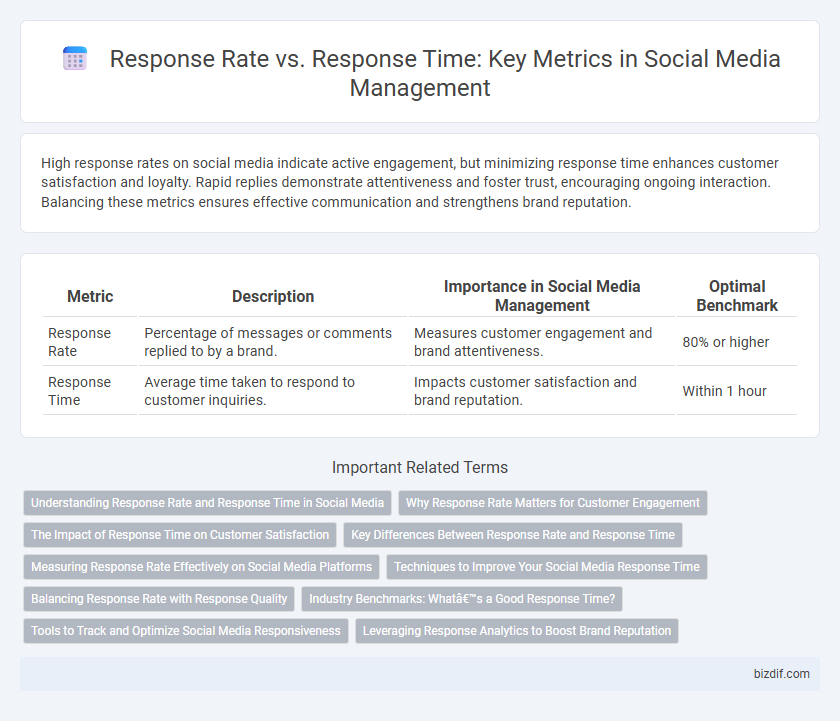High response rates on social media indicate active engagement, but minimizing response time enhances customer satisfaction and loyalty. Rapid replies demonstrate attentiveness and foster trust, encouraging ongoing interaction. Balancing these metrics ensures effective communication and strengthens brand reputation.
Table of Comparison
| Metric | Description | Importance in Social Media Management | Optimal Benchmark |
|---|---|---|---|
| Response Rate | Percentage of messages or comments replied to by a brand. | Measures customer engagement and brand attentiveness. | 80% or higher |
| Response Time | Average time taken to respond to customer inquiries. | Impacts customer satisfaction and brand reputation. | Within 1 hour |
Understanding Response Rate and Response Time in Social Media
Response rate in social media management measures the percentage of customer inquiries or messages that receive a reply, reflecting a brand's engagement level. Response time indicates the average duration between receiving a message and delivering a response, impacting customer satisfaction and retention. Optimizing both metrics enhances user experience by ensuring timely and consistent communication across platforms.
Why Response Rate Matters for Customer Engagement
High response rates on social media directly enhance customer engagement by demonstrating brand attentiveness and reliability. A consistently elevated response rate fosters trust, encouraging customers to interact more frequently and share feedback. Optimizing response rate is critical for building lasting relationships and improving overall customer satisfaction metrics.
The Impact of Response Time on Customer Satisfaction
Response time directly influences customer satisfaction by shaping user expectations in social media management. Quick responses signal attentiveness and reliability, increasing user engagement and loyalty while reducing frustration. Platforms with average response times under one hour often report satisfaction rates above 80%, highlighting the importance of timely interactions.
Key Differences Between Response Rate and Response Time
Response rate measures the percentage of customer inquiries answered, reflecting engagement efficiency, while response time tracks the average duration taken to reply, indicating speed of service. High response rates demonstrate effective communication coverage, whereas low response times signify promptness in addressing user concerns. Balancing both metrics is crucial for optimizing social media management performance and enhancing customer satisfaction.
Measuring Response Rate Effectively on Social Media Platforms
Measuring response rate effectively on social media platforms involves calculating the percentage of user inquiries or comments that receive replies within a given timeframe, ensuring brands maintain high engagement levels. Tracking response rate alongside response time allows businesses to identify responsiveness trends and optimize customer service strategies. Leveraging analytics tools that monitor response metrics across platforms like Twitter, Facebook, and Instagram enhances accuracy in evaluating social media performance.
Techniques to Improve Your Social Media Response Time
Techniques to improve your social media response time include monitoring notifications in real-time, using automated chatbots for instant replies, and setting clear internal response time goals. Employing social media management tools like Hootsuite or Sprout Social enables efficient message tracking and rapid response allocation. Training your team to prioritize urgent queries also boosts response rate and decreases average reply time, enhancing overall customer satisfaction.
Balancing Response Rate with Response Quality
Maximizing response rate in social media management should not compromise response quality, as prompt but well-crafted replies foster stronger customer engagement and trust. Prioritizing thoughtful, personalized interactions often leads to higher satisfaction and brand loyalty, even if it slightly increases response time. Leveraging analytics tools can help identify the optimal balance to maintain both timely and meaningful communication.
Industry Benchmarks: What’s a Good Response Time?
Industry benchmarks for social media response time indicate most brands achieve an average of 1 to 3 hours, with top performers responding within 15 to 30 minutes to maintain high engagement levels. A 90% response rate paired with under 1 hour response time significantly boosts customer satisfaction and brand loyalty. Fast response times align with consumer expectations, as 75% of users expect replies on social media within an hour.
Tools to Track and Optimize Social Media Responsiveness
Tools like Sprout Social and Hootsuite provide comprehensive dashboards to monitor response rate and response time, enabling social media managers to identify gaps in engagement. Real-time analytics track average reply times, helping teams prioritize interactions and improve customer satisfaction. Automated alerts and performance reports facilitate continuous optimization of social media responsiveness strategies.
Leveraging Response Analytics to Boost Brand Reputation
Leveraging response analytics enables brands to monitor response rate and response time effectively, revealing customer engagement patterns and identifying improvement areas. High response rates paired with swift response times significantly enhance brand reputation by demonstrating reliability and attentiveness. Optimizing these metrics through advanced social media management tools fosters stronger customer relationships and drives positive brand perception.
response rate vs response time Infographic

 bizdif.com
bizdif.com